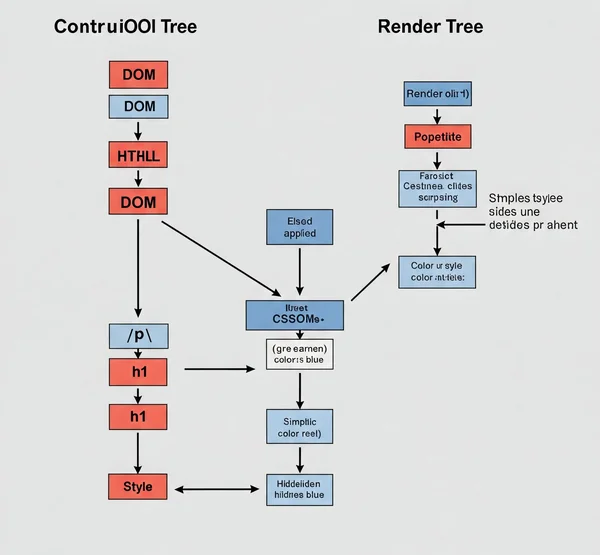Understanding HTML Rendering: Visualize It with Our Viewer
From Code to Pixels: Demystifying HTML Rendering & Our Viewer's Role
Have you ever wondered how the lines of HTML code you write magically transform into the vibrant, interactive web pages you see on your screen? This transformation isn't magic, but a sophisticated process known as browser rendering. How does html render? While the full journey can be complex, understanding the basics is crucial for any web developer or aspiring coder. This article aims to demystify the key stages of HTML rendering and show how an online HTML viewer can help you visualize html rendering and see your code come to life instantly.
What is HTML Rendering? The Basics Explained
What is html rendering? At its core, HTML rendering is the process by which a web browser takes your HTML document (along with CSS and JavaScript) and converts it into the visual webpage that users interact with. It’s the bridge between textual instructions and a graphical user interface.
The Journey from HTML Document to Visual Webpage
This journey involves several critical steps, from parsing the raw HTML to painting the final pixels on the screen. Each step builds upon the previous one to progressively construct the page. Understanding this flow can significantly enhance your ability to write efficient and effective code.

Why Understanding Rendering Matters for Developers
Why should developers care about understanding rendering? A solid grasp of this process helps in:
- Performance Optimization: Knowing how browsers work allows you to write code that renders faster, leading to better user experiences.
- Debugging: Many layout and style issues become easier to diagnose when you understand the underlying rendering mechanics.
- Advanced Techniques: Concepts like the critical rendering path are built upon this foundational knowledge. For anyone serious about web development, this knowledge is invaluable.
Key Stages in the Browser Rendering Process
The browser rendering process can be broken down into several key stages. While different browser engines might have slight variations, the general principles are similar.
Step 1: Parsing HTML – Building the DOM Tree
The process begins when the browser receives the HTML document. It starts parsing HTML from top to bottom. During this parsing phase, the browser converts the stream of HTML characters into a tree-like structure of objects called the Document Object Model (DOM). Each HTML tag becomes a node in this DOM tree, representing the document's structure and content.
Step 2: Processing CSS – Constructing the CSSOM Tree
Simultaneously, or shortly after, the browser encounters CSS (either in <style> tags, inline styles, or linked external stylesheets). It begins processing CSS rules to determine how each DOM element should look. This process results in another tree-like structure called the CSS Object Model (CSSOM). The CSSOM tree contains style information for all the corresponding DOM nodes.
Step 3: Combining DOM and CSSOM – Creating the Render Tree
Once both the DOM tree and CSSOM tree are constructed, they are combined to form the render tree. This tree is crucial because it only includes the nodes that will actually be displayed on the page. For example, elements styled with display: none; or non-visual elements like <head> or <script> are omitted from the render tree.

Step 4: Layout (or Reflow) – Calculating Geometry
With the render tree in place, the browser moves to the layout stage, also known as "reflow." During this phase, the browser calculates the exact size and position of each visible node in the render tree on the viewport. It determines the geometry – where each box should go and how big it should be. Any change that affects an element's geometry (like changing width, height, or position) can trigger a reflow for part or all of the document.
Step 5: Painting (or Rasterizing) – Drawing Pixels to the Screen
Finally, in the painting stage (sometimes called "rasterizing"), the browser takes the calculated geometry from the layout stage and "draws" the actual pixels onto the screen. It converts each node in the render tree into on-screen pixels, considering properties like color, background, borders, and text. This is the stage where you finally see the visual representation of your code.
How Our Online HTML Viewer Helps Visualize Rendering
While you can't see these internal browser trees directly without developer tools, an online HTML viewer provides an excellent way to visualize html rendering at a more immediate level.
Instant Feedback: Simulating the "Painting" Stage
When you use our HTML preview tool, you get instant feedback. As you type or paste your HTML, the preview pane immediately updates. This rapid update effectively simulates the final "painting" stage of the browser rendering process. You're seeing the direct visual consequence of your HTML structure and inline styles, much like the browser's final output.

Focusing on HTML Structure and Its Visual Output
An online html viewer helps you focus on the relationship between your raw HTML structure and its visual output. It simplifies the complex rendering pipeline by abstracting away the intermediate steps like explicit DOM/CSSOM/Render Tree construction, allowing you to directly observe how your HTML markup translates into a view. This is particularly helpful for understanding the impact of different tags and attributes.
Experimenting with Code to See Rendering Changes in Real-Time
The ability to experiment with code and see rendering changes in real-time is invaluable for learning. You can tweak a tag, change an attribute, or add an inline style, and our online renderer will instantly show you the result. This hands-on approach solidifies your understanding of how HTML behaves when rendered.
Practical Benefits of Visualizing HTML Rendering
Understanding and being able to visualize html rendering has tangible benefits.
Better Debugging of Layout and Style Issues
When you can instantly see how your code renders, it becomes easier to spot and debug layout and style issues. If an element isn't appearing where you expect, observing the live preview as you adjust its HTML or CSS can quickly lead you to the root cause.
Improved Understanding for HTML & CSS Learners
For HTML CSS learners, the connection between code and visual output can sometimes feel abstract. An online html viewer makes this connection concrete and immediate, accelerating the learning process and making it more intuitive to understand html rendering.

See Your Code Come to Life: Understanding HTML Rendering Matters
The journey from a simple HTML document to a fully rendered visual webpage is a fascinating dance of parsing, calculation, and painting. While the full browser rendering pipeline is intricate, grasping the fundamental stages empowers you as a developer. Tools that offer an html preview online can be instrumental in bridging the gap between theory and practice.
Start visualizing how your code transforms into web pages today. By experimenting with code in an HTML viewer like ours, you can truly see your code come to life and deepen your understanding of HTML rendering. What part of the HTML rendering process do you find most fascinating or confusing? Share your thoughts in the comments!
HTML Rendering and Visualization Tools
Here are some common questions about HTML rendering and how tools can help:
-
Does an online HTML viewer show the entire browser rendering pipeline? No, typically an
online HTML viewerorhtml rendererfocuses on displaying the final visual output of your HTML and inline CSS. It simplifies the complex internalbrowser renderingpipeline (like DOM/CSSOM/Render Tree construction) to provide an immediate, understandable preview of how your code will look, rather than detailing each intermediate step. Our tool is designed for this direct visualization. -
What's the difference between HTML rendering and HTML parsing?
HTML parsingis a specific, early step within the overallHTML renderingprocess. Parsing involves reading the HTML document and building the DOM tree.HTML renderingencompasses the entire sequence of events, from parsing through layout and finally painting the pixels on the screen. -
How can I render HTML online quickly? The fastest way to
render html onlineis to use a dedicatedonline HTML viewerorhtml preview onlinetool. You can simply paste your HTML code into the tool, like this one, and it will display the rendered output almost instantly. -
Can visualizing rendering help with web performance? Yes, indirectly. While an online viewer itself doesn't analyze performance,
understanding renderingconcepts like "reflow" and "repaint" (which are part of the layout and painting stages) helps you write HTML and CSS that minimizes these computationally expensive operations. This knowledge, aided by visualizing how changes affect output, can lead to better web performance.